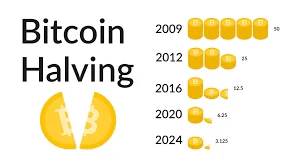Bitcoin, the pioneer of cryptocurrencies, operates on a unique system that sets it apart from traditional fiat currencies. One crucial aspect that shapes the behavior and supply of Bitcoin is the process known as "Bitcoin halving." In this blog post, we will delve into the intricacies of Bitcoin halving, exploring what it is, why it happens, and the potential implications for the cryptocurrency market.
What is Bitcoin Halving?
Bitcoin halving is a pre-programmed event embedded in the Bitcoin protocol, occurring approximately every four years or after every 210,000 blocks are mined. During this event, the rewards that miners receive for validating and adding new transactions to the blockchain are halved. The initial reward was 50 bitcoins per block, and it has successively reduced to 25, 12.5, and so on.
The Purpose of Bitcoin Halving:
Controlled Supply: Bitcoin halving is designed to control the supply of new bitcoins entering circulation. By reducing the rate at which new coins are created, Bitcoin aims to emulate the scarcity and value proposition of precious metals like gold.
Market Dynamics: The reduced reward impacts the incentives for miners, potentially influencing their behavior. Miners must adapt to the decreased rewards, which may lead to increased competition and more efficient mining practices.
Price Impact: Historically, Bitcoin halving events have been associated with significant price movements. The anticipation and aftermath of halving often generate increased interest and speculation in the cryptocurrency market.
Bitcoin Halving Explained:
Mining Process: Bitcoin operates on a Proof-of-Work (PoW) consensus algorithm. Miners use powerful computers to solve complex mathematical problems, and the first one to solve it gets the right to add a new block to the blockchain and is rewarded with bitcoins.
Halving Schedule: The Bitcoin halving occurs roughly every 210,000 blocks, which translates to approximately every four years. The first halving took place in 2012, followed by subsequent events in 2016 and 2020.
Impact on Supply: After each halving, the rate at which new bitcoins are generated is halved. This reduction in the rate of supply contributes to Bitcoin's deflationary nature.
Historical Implications:
Price Surges: Previous Bitcoin halving events have been associated with significant price rallies. While past performance doesn't guarantee future results, the scarcity narrative tends to attract investors looking to capitalize on potential price appreciation.
Market Sentiment: Halving events often create a buzz in the cryptocurrency community. The anticipation and discussions surrounding halving contribute to increased market sentiment and interest.
Miner Adaptation: Reduced rewards force miners to adapt by improving efficiency, upgrading equipment, or exploring alternative revenue streams.
Conclusion:
Bitcoin halving is a pivotal event that plays a crucial role in shaping the dynamics of the cryptocurrency market. As Bitcoin continues to gain mainstream acceptance, the impact of halving events on its price and market dynamics will likely remain a topic of interest for investors, enthusiasts, and analysts alike. Understanding the mechanics and implications of Bitcoin halving is essential for anyone navigating the exciting and evolving world of cryptocurrencies.
